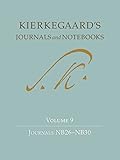Kierkegaard's Journals and Notebooks, Volume 9 : Journals NB26-NB30 / Søren Kierkegaard; David D. Possen, Søren Kierkegaard Research Centre, Vanessa Rumble, Joel D.S. Rasmussen, Bruce H. Kirmmse, Niels Jørgen Cappelørn, Alastair Hannay.
Material type: TextSeries: Kierkegaard's Journals and Notebooks ; 12Publisher: Princeton, NJ : Princeton University Press, [2017]Copyright date: ©2017Edition: in cooperation with the Søren Kierkegaard Research Centre, CopenhagenDescription: 1 online resource : 10 halftonesContent type:
TextSeries: Kierkegaard's Journals and Notebooks ; 12Publisher: Princeton, NJ : Princeton University Press, [2017]Copyright date: ©2017Edition: in cooperation with the Søren Kierkegaard Research Centre, CopenhagenDescription: 1 online resource : 10 halftonesContent type: - 9780691172415
- 9781400883752
- 198.9
- online - DeGruyter
- Issued also in print.
| Item type | Current library | Call number | URL | Status | Notes | Barcode | |
|---|---|---|---|---|---|---|---|
 eBook
eBook
|
Biblioteca "Angelicum" Pont. Univ. S.Tommaso d'Aquino Nuvola online | online - DeGruyter (Browse shelf(Opens below)) | Online access | Not for loan (Accesso limitato) | Accesso per gli utenti autorizzati / Access for authorized users | (dgr)9781400883752 |
Frontmatter -- Contents -- Introduction to the English Language Edition -- Journal NB 26 -- Journal NB 27 -- Journal NB 28 -- Journal NB 29 -- Journal NB 30 -- Notes for Journal NB 26 -- Notes for Journal NB 27 -- Notes for Journal NB 28 -- Notes for Journal NB 29 -- Notes for Journal NB 30 -- Maps -- Calendar -- Concordance
For over a century, the Danish thinker Søren Kierkegaard (1813-55) has been at the center of a number of important discussions, concerning not only philosophy and theology, but also, more recently, fields such as social thought, psychology, and contemporary aesthetics, especially literary theory.Despite his relatively short life, Kierkegaard was an extraordinarily prolific writer, as attested to by the 26-volume Princeton University Press edition of all of his published writings. But Kierkegaard left behind nearly as much unpublished writing, most of which consists of what are called his "journals and notebooks." Kierkegaard has long been recognized as one of history's great journal keepers, but only rather small portions of his journals and notebooks are what we usually understand by the term "diaries." By far the greater part of Kierkegaard's journals and notebooks consists of reflections on a myriad of subjects-philosophical, religious, political, personal. Studying his journals and notebooks takes us into his workshop, where we can see his entire universe of thought. We can witness the genesis of his published works, to be sure-but we can also see whole galaxies of concepts, new insights, and fragments, large and small, of partially (or almost entirely) completed but unpublished works. Kierkegaard's Journals and Notebooks enables us to see the thinker in dialogue with his times and with himself.Kierkegaard wrote his journals in a two-column format, one for his initial entries and the second for the extensive marginal comments that he added later. This edition of the journals reproduces this format, includes several photographs of original manuscript pages, and contains extensive scholarly commentary on the various entries and on the history of the manuscripts being reproduced.Volume 9 of this 11-volume series includes five of Kierkegaard's important "NB" journals (Journals NB26 through NB30), which span from June 1852 to August 1854. This period was marked by Kierkegaard's increasing preoccupation with what he saw as an unbridgeable gulf in Christianity-between the absolute ideal of the religion of the New Testament and the official, state-sanctioned culture of "Christendom," which, embodied by the Danish People's Church, Kierkegaard rejected with increasing vehemence. Crucially, Kierkegaard's nemesis, Bishop Jakob Peter Mynster, died during this period and, in the months following, Kierkegaard can be seen moving inexorably toward the famous "attack on Christendom" with which he ended his life.
Issued also in print.
Mode of access: Internet via World Wide Web.
In English.
Description based on online resource; title from PDF title page (publisher's Web site, viewed 23. Mai 2019)


